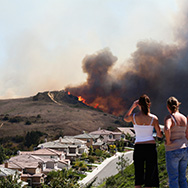As development continues to grow in Queensland, it means more and more properties are being built in areas that are potentially susceptible to bushfire risk, particularly during the peak of bushfire season. Development on the urban/bushland fringe is continuing to expand, which is causing properties to more frequently encroach into bushland areas.
The very nature of bushland areas, mixed with changing weather systems in Queensland, means the number of bushfire events and their intensity is increasing. In order to protect homes, community uses and businesses located in bushfire-prone areas, proper planning, risk assessment and risk mitigation measures must be implemented.
Bushfire management / planning
While there has always been an inherent risk with taking up residence in a bushfire-prone location, the simple fact is that this conflict has long remained in Australia, largely due to our affinity with bushland environments. Much like dealing with the potential risks of floods in flood-prone areas of Queensland, bushfire management and planning comes down to assessing the potential of such risk and what measures can be taken to mitigate this.
The Queensland government already outlines key requirements for homes built in bushfire-prone areas, which all property developers should take time out to look through. The key standards for new homes, as listed on this site, are as follows:
- a concrete slab on which the house is constructed
- exterior walls, roof, veranda or deck constructed from non-combustible materials
- sealed wall and roof joints to guard against ember attacks
- shutters made from aluminium (or other non-combustible material)
- toughened glass windows
- fire-resistant-timber door frames, with a weather strip at the base
- metal (rather than plastic) external trimmings such as vents, guttering and downpipes
In the interest of safety, buffer zones should be a core aspect of all development (e.g. areas which make it difficult for bushfire to travel up to the doorstep). In essence, the better the bushfire-responsive development, the lower the construction requirements.
The above are a very small example of precautions and steps that need to be taken with regard to development in a bushfire area. Consideration of bushfire early in the urban design and planning stage can achieve much more favourable results both in terms of development yield, lower construction costs and requirements and improved community resilience. Yes, you can develop in a bushfire-prone area, but you need to ensure you develop with the unique risks of that area in mind.
At Jensen Bowers, we specialise in bushfire management / planning related to development projects. To start a conversation, visit our Contact Us page or call us on (07) 3852 1771.


